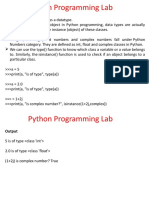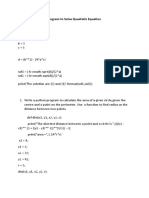0 ratings0% found this document useful (0 votes)
57 viewsPython Notes
Python supports two types of type conversion: implicit and explicit. Implicit conversion occurs automatically, such as when an integer is added to a float which results in a float. Explicit conversion uses functions like int(), float(), and str() to manually convert between types. The pass statement in Python is a null operation that is used when a statement is required syntactically but no operation needs to be performed.
Uploaded by
roseCopyright
© © All Rights Reserved
We take content rights seriously. If you suspect this is your content, claim it here.
Available Formats
Download as DOCX, PDF, TXT or read online on Scribd
0 ratings0% found this document useful (0 votes)
57 viewsPython Notes
Python supports two types of type conversion: implicit and explicit. Implicit conversion occurs automatically, such as when an integer is added to a float which results in a float. Explicit conversion uses functions like int(), float(), and str() to manually convert between types. The pass statement in Python is a null operation that is used when a statement is required syntactically but no operation needs to be performed.
Uploaded by
roseCopyright
© © All Rights Reserved
We take content rights seriously. If you suspect this is your content, claim it here.
Available Formats
Download as DOCX, PDF, TXT or read online on Scribd
You are on page 1/ 2
Python notes
Type Conversion
The process of converting the value of one data type (integer, string, float,
etc.) to another is called type conversion. Python has two types of type
conversion.
Implicit Type Conversion
Implicit conversion doesn't need any user involvement. For example:
num_int = 123 # integer type
num_flo = 1.23 # float type
num_new = num_int + num_flo
print("Value of num_new:",num_new)
print("datatype of num_new:",type(num_new))
When you run the program, the output will be:
Value of num_new: 124.23
datatype of num_new: datatype of num_new: <class 'float'>
Here, num_new has float data type because Python always converts smaller
data type to larger data type to avoid the loss of data.
Here is an example where Python interpreter cannot implicitly type convert.
num_int = 123 # int type
num_str = "456" # str type
print(num_int+num_str)
When you run the program, you will get
TypeError: unsupported operand type(s) for +: 'int' and 'str'
However, Python has a solution for this type of situation which is know as
explicit conversion.
Explicit Conversion
In case of explicit conversion, you convert the datatype of an object to the
required data type. We use predefined functions like int(), float(), str() etc.
to perform explicit type conversion. For example:
num_int = 123 # int type
num_str = "456" # str type
# explicitly converted to int type
num_str = int(num_str)
print(num_int+num_str)
What is pass statement in Python?
In Python programming, the pass statement is a null
statement. The difference between a comment and a pass
statement in Python is that while the interpreter ignores a
comment entirely, pass is not ignored.
However, nothing happens when the pass is executed. It
results in no operation (NOP).
You might also like
- Python Programming Lab: Data Types in PythonNo ratings yetPython Programming Lab: Data Types in Python24 pages
- Unit - 2 - Data Types, IO, Types of Errors and Control - StructuresNo ratings yetUnit - 2 - Data Types, IO, Types of Errors and Control - Structures18 pages
- Python Data Types - Jupyter Notebook_017ae85a1acb61f561c41b1ab55449c7No ratings yetPython Data Types - Jupyter Notebook_017ae85a1acb61f561c41b1ab55449c717 pages
- CH 5 Getting Started With Python Part 2No ratings yetCH 5 Getting Started With Python Part 211 pages
- Python_Lecture_2(Variables & Exprission)No ratings yetPython_Lecture_2(Variables & Exprission)41 pages
- Complex Data Type Is Used To Reserve Memory For Complex Literals or NumbersNo ratings yetComplex Data Type Is Used To Reserve Memory For Complex Literals or Numbers6 pages
- FALLSEM2024-25 BCSE101E ETH VL2024250107671 2024-08-10 Reference-Material-INo ratings yetFALLSEM2024-25 BCSE101E ETH VL2024250107671 2024-08-10 Reference-Material-I85 pages
- How Data Structure Differs/varies From Data TypeNo ratings yetHow Data Structure Differs/varies From Data Type142 pages
- FALLSEM2024-25 BCSE101E ETH VL2024250107671 2024-08-06 Reference-Material-INo ratings yetFALLSEM2024-25 BCSE101E ETH VL2024250107671 2024-08-06 Reference-Material-I44 pages
- Python for Data Science: Data Science Mastery by Nikhil Khan, #1From EverandPython for Data Science: Data Science Mastery by Nikhil Khan, #1No ratings yet
- 2020 11 03SupplementaryBE101 05BE10105 I Ktu QbankNo ratings yet2020 11 03SupplementaryBE101 05BE10105 I Ktu Qbank3 pages
- Answer All Questions, Each Carries2 or 3 Marks.: D A192010 Pages: 2No ratings yetAnswer All Questions, Each Carries2 or 3 Marks.: D A192010 Pages: 22 pages
- Write A Python Program To Solve Quadratic EquationNo ratings yetWrite A Python Program To Solve Quadratic Equation6 pages


































































